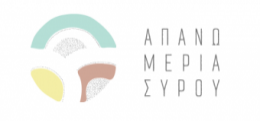
by François Aron
The French archaeologist, François Aron, traveled to Syros in the 1980s and, by doing surface research, attempted, on the basis of archaeological finds, to locate prehistoric habitation places on the island. The findings of his research were published in 1995 in Syros Letters, Vol. 30, from where we report here the findings related to Apano Meria.
Chalara
People settled west of the spring of Syringa, in a landscape with more fragmentation than other Early Cycladic sites in Syros. A thick marble layer was cracked and torn into slabs, sometimes suspended between boulders of all sizes. The exploration of the caves and the rocks did not work: the settlement did not start, as is sometimes the case with the rocky shelters, before settling in the countryside, although these parts may have been used as storage areas or pens. We find traces of habitation on the steps between the rocks—sometimes near the entrance to the caves—but also on the platforms, the hollows and especially on the flat surfaces, surrounded by natural cracks. On one of the flats, 150 square meters in size. and a slope of about 15°, many remains were found, as well as schistolith plates probably used in constructions. Buildings also consisted of small volumes of marble, but there are no clear traces of walls. The conical cores and arrowheads with stem and hooks that were found are of Neolithic type, and only the spikes are formed by overlapping treatment. An opaque, scraper with flakes and blades and one scraper of flint are the only tools that are formed by peripheral processing, but they also must have used the blades as unprocessed tools. Ceramic art is limited and is kept in poor condition. As for the construction, it looks like that from Chontra of Vari, (where the polished surface of the vessels has a beautiful brown, glossy color, but no written shell was found.) The most common shape of the bottle is the conical, the hemispherical ones are rarer, and in the Chontra we see large utensils with strap handles is however better cooked and granular (sic). A ring-shaped bottle, 1 hemispherical, 1 with a leg, and other ones with vertical walls were found. The relative abundance of closed vessels may be related to a specific function of position (dairies vessels?). This site, modern, earlier or later than the Chontra, has particular cultural features, which suggests that the settlement of Syros at the end of the Neolithic period took place by different groups, perhaps even living in the same place. However, we cannot rule out the assumption that the 10 sites found in Syros belong to the same culture, but they are not modern and some of them were pens or stables.
The immediate natural environment of Chalara has similarities with the Atziganokastro of Syros, but spreads to a greater extent, in a much more scarp area. Perhaps the different groups of people, depending on their size, had been settled in isolated and naturally protected areas. Their bonds were probably weaker and the total number smaller, since the areas that seem to have been inhabited, account for only 10-30 dwelling units, according to our calculations.
From Chalara we enjoy the open view to the northern part of the island and to the sea, at a distance of 20 minutes of the hour, a distance that ensured the safety of the settlement, but also allowed part of their food to be fished (some sea shells were found). The inhabitants must also practice the livestock farming (some caves are still nowadays used as pens), use the water from the Syringas spring and have the supervision of the pastures and perhaps the fields in the northern part of the island. In the immediate area of Chalara, there are 2-3 hectares of arable land, and perhaps in the surrounding ridges the soil was not completely swept away by the erosion.
Akra (Quarry)
A small settlement is found on the western slope of Akra, above the bay of Dolphin, on a flat fold of marble below the quarry. Ceramics, without being particularly diagnostic, must belong to the Early Cycladic II. The stonework includes blades and trimmers with parallel sides and a considerable number of processed tools, which may mean a relatively early site dating (beginning of the period).
San Michael
The shells that were collected on the village’s location date back to the 2nd millennium, mainly during the Greek-Roman era. Some ambiguous shells and perhaps one bottle shell with an internally bulging lip could be dated to the beginning of the Early Cycladic. There are no obsidian, only 1 scraper from a flint, maybe the 2nd millennium. On the sides of the Mavrovolades, 400 meters east of the site, the clay of one shell reminds the end of the Neolithic or the beginning of the Early Bronze Age. If this is true, it may have been transported there during the fertilization of the fields, but nothing can indicate when the shell was transferred.
Pyrgos (Plateau)
From a marble protrusion on the western edge of the plateau, which extends to the west of the highest point of Syros, there is a small collection of obsidian with a high frequency of processed tools and pointed arrows with staff and fins, but the processing is less thoughtful than that in Chontra. The pottery is scarce, we note 1 spherical bottle. There is still a small arable land at the edge of the plateau, from where a narrow valley begins, but the location, probably a very small village, seems more suitable for livestock farming.
Translated by Constantine Hatziadoniu
